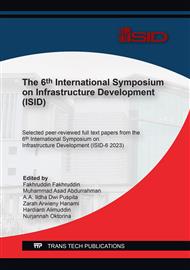p.41
p.47
p.57
p.69
p.81
p.93
p.103
p.115
p.123
Properties of Composite Panel as Wall Structure for Housing
Abstract:
As a country within the World Ring of Fire, Indonesia is a country prone to natural disasters such as earthquakes. As a result, casualties, damage to buildings and limited access to a number of isolated locations in remote areas. However, the handling of victims should not be slowed down. The development of civil engineering supports environmentally friendly behavior while creating building innovations from small mass materials that are able to reduce the weight of the building itself which has been a problem with the magnitude of the impact of earthquakes. The author conducted mechanical testing on lightweight concrete sandwich panel material as an initial study of the concept of earthquake-resistant houses. A number of tests were carried out, compressive strength on typical sandwich panels with wiremesh reinforcement, flexure tests, and shear tests on composite materials to develop the shear capacity of the panels in receiving the earthquake load distribution received by the building. For the purpose of maximizing the sliding capacity of wall panels, shear joint engineering has been obtained with the addition of glue and connectors. Respectively, the addition of 10 diameter threaded iron connectors is able to increase the load achievement by 10%, and then the addition of connectors and glue is able to increase the load capacity by 30%.
Info:
Periodical:
Pages:
115-121
Citation:
Online since:
June 2025
Keywords:
Price:
Сopyright:
© 2025 Trans Tech Publications Ltd. All Rights Reserved
Share:
Citation:


